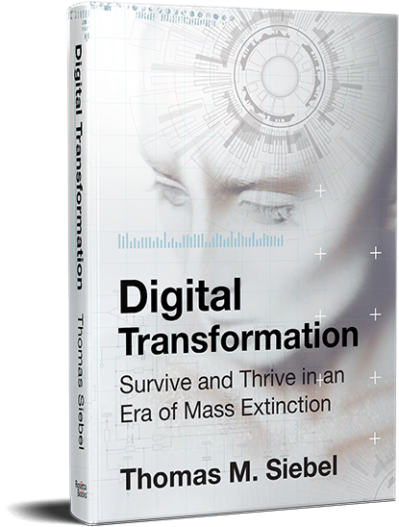Some of the most meaningful technological advances are the ones that enable humanity to solve a previously unsolvable problem — to treat a deadly disease, for instance. But all too often, these advances brings about equally dramatic downsides: business models become obsolete, jobs disappear, employers shut their doors.
Bestselling author and C3.ai CEO Tom Siebel has written about the challenges of technological upheaval in Digital Transformation: Survive and Thrive in an Era of Mass Extinction. On this episode of Mastering Innovation on SiriusXM Channel 132, Business Radio Powered by The Wharton School, he spoke with host Saikat Chaudhuri about the problems that will be solved by artificial intelligence, as well as the leadership qualities that will be most useful in countering the threats that AI poses.
An excerpt of the interview is transcribed below. Listen to more episodes here.
Transcript
Saikat Chaudhuri: You talk in your book, but also generally, about how corporations and various kinds of organizations will dramatically need to transform themselves in order to prepare for a world where, as you describe, products, processes, business models, and organizations themselves are going to have to operate fundamentally differently from what they did before. Can you tell us a little bit more about why you think they need to make such dramatic transformations and why being slow in the process is not going to help?

Tom Siebel: Anytime we adopt new technologies, there is resistance. People are scared of these technologies: they threaten jobs, and people resist. This goes back to the steam engine, the Jakarta Loom, the automobile, the production line — all of these developments were unstoppable. The Gutenberg Press, okay? They were unstoppable developments, but they threatened a lot of jobs and they threatened a lot of people.
One of the most prolific or ubiquitous applications of artificial intelligence will be in the area of AI-based predictive maintenance, where we look at devices or human beings and we can predict device failure with high levels of precision before it happens, whether this is the failure in the automotive engine, whether it’s a failure of an auxiliary power unit in an aircraft, or whether it’s a failure of a human heart. Today, the way the system works is we wait for the heart to fail and then we deal with it. We wait for the engine to fail and we call the mechanic.
Now, we have in many organizations tens of thousands of people involved in systems maintenance. For example, in large grid operators or oil fields or our farm equipment or automobiles, we have hundreds of thousands, millions of people involved in maintenance. And they’ve been trained to do it a certain way. Every 30 days they do this, every 90 days they do this, once a year they do that. And we have union contracts that say how we’re going to work. We have compensation structures that incent the way that we’re going to work; we have been trained in school to do things certain ways.
“We need to change training programs, we need to change management programs, we need to change the union contracts, and we need to change compensation plans. We need to change, and we will change.” — Tom Siebel
Well now, with AI-based predictive maintenance, it changes everything about the maintenance procedure. We don’t do things every 30 days, every 60 days, or drive down the power line structure writing down the names and writing down the numbers on every meter once a month. It’s different. We have analytics that tell us that this transformer is going to fail in the next 30 days; it’s a 90% probability of failure and this is why it’s going to fail. And then you go fix that transformer.
If you’ve been doing the job for 30 years you might think, “Nobody’s going to tell me how to do my job.” So in order for this to happen at mass scale with organizations with tens to hundreds of thousands of people, we need to change training programs, we need to change management programs, we need to change the union contracts, and we need to change compensation plans. We need to change, and we will change. Companies who succeed at this will change everything about the way they operate their businesses.
Chaudhuri: Historically, we’ve seen a number of examples of incumbency of different firms and how they’ve been able to either transform, or not transform and have succumbed. If we think about the Kodak example, if we think about Rim and Blackberry, or perhaps the bookstore companies such as Borders after the advent of Amazon, we’ve seen this phenomenon take place before. Those who’ve been able to adapt have survived, and those who haven’t, haven’t been able to. Do you think that, especially with the title of your book being “in an Era of Mass Extinction,” is this situation that we’re facing today more acute than before?

Siebel: Unquestionably. I don’t think digital transformation is a causal factor. But the fact is that we are experiencing, in the first part of the 21st century, a mass extinction event in the corporate world. Since 2000, more than 52% of the Fortune 500 companies have disappeared from the planet. They’ve either been merged or they’ve gone bankrupt. Where’s Westinghouse, where’s Kodak? Where is Toys ‘R Us, where is Sears Roebuck? These companies, the institutions, have just disappeared.
In their place, we find companies emerging with new DNA, companies like Amazon, Airbnb, Tesla, Lyft. And all these companies are very much about elastic cloud computing, AI, the internet, the Internet of Things, and Big Data applied to retailing, transportation, whatever it might be. Look at Uber: no cars, no drivers, and they’re completely upending the transportation business. Look at Amazon until recently: no stores, and they’re just rolling the retail market. There are big changes going on at an accelerated rate, and there are companies that will take advantage of these new technologies and companies that won’t. Those that do will continue to grow and succeed and those that don’t will be acquired.
“The fact is that we are experiencing, in the first part of the 21st century, a mass extinction event in the corporate world.” — Tom Siebel
Chaudhuri: The challenge is pretty acute and companies have to change. What’s exciting about this versus the 1990s wave is that every industry is affected now. It’s not just about IT; it’s not just about hardware and software per se; it’s really from the auto industry, to healthcare, to the financial industry with the advent of Fintech, to retail — everything’s being affected. From your experience, having been a tech executive as well as an entrepreneur, how do companies prepare themselves for these changes, both to recognize them but also to act upon them?
I ask because, like you said, it’s very difficult for an organization to adapt, and it seems like only a crisis precipitates some sort of change. We’ve seen that with Apple, with IBM, even some of these great companies that have survived, and perhaps even with some of the new ones like the Googles who are going through their own issues at the moment, or the Facebooks. How do we recognize what we need to change and then how do we go about overcoming the resistance that you were talking about earlier, that inertia?
Siebel: The companies that we’re involved in are excelling at digital transformation, are applying these technologies to drive costs out of their business, to serve their customers better, to deliver products faster at lower cost into the hands of more satisfied customers — organizations like Royal Dutch Shell, Baker Hughes, Caterpillar, 3M, the Department of Defense, etc. They have leaders who are very switched on. They read; they have a book in their hand. And they understand what’s going on in the marketplace. They’re not sitting around just waiting to retire so they can collect their pension. They’re trying to drive the company into the next era.
We see CEOs who are great leaders, like Isabelle Kocher at Engie in Paris, or Francesco Starace at Enel in Italy, or Mike Roman at 3M in Minneapolis, or Ryan McCarthy, the Under Secretary of the Army. These people have a book in their hand, they’ve taken the time to understand these new technologies, they’ve read about AI, and they’ve read about big data. They’re personally aware of what’s going on with elastic cloud computing. They’re getting their management teams together; they’re assuring them that they’re aware of what this technology is all about. And then they’re going out and making change happen. So these are very much in every organization we’re seeing that’s killing it, these are CEO-led initiatives.
About Our Guest
Thomas M. Siebel is CEO of C3.ai, a leading provider of enterprise artificial intelligence software, and author of the Wall Street Journal bestseller Digital Transformation: Survive and Thrive in an Era of Mass Extinction. A globally renowned leader in information technology, Mr. Siebel has been at the forefront of several major innovation cycles, including relational databases, enterprise application software, Internet computing, AI, and the Internet of things. He pioneered the customer relationship management (CRM) category with the founding of Siebel Systems. Recognized by Businessweek as one of the top 25 managers in global business, Mr. Siebel is a three-time recipient of the EY Entrepreneur of the Year award and was named a Glassdoor Top CEO in 2018. He was elected to the American Academy of Arts and Sciences in 2013.



